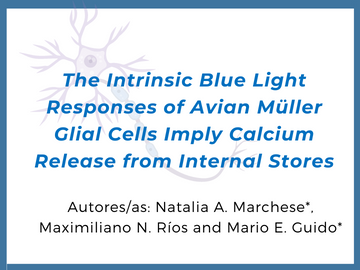The Intrinsic Blue Light Responses of Avian Müller Glial Cells Imply Calcium Release from Internal Stores
Abstract
The retina of vertebrates is responsible for capturing light through visual (cones and rods) and non-visual photoreceptors (intrinsically photosensitive retinal ganglion cells and horizontal cells) triggering a number of essential activities associated to image- and non-image forming functions (photic entrainment of daily rhythms, pupillary light reflexes, pineal melatonin inhibition, among others). Although the retina contains diverse types of neuronal based-photoreceptors cells, originally classified as ciliary- or rhabdomeric-like types, in recent years, it has been shown that the major glial cell type of the retina, the Müller glial cells (MC), express blue photopigments as Opn3 (encephalopsin) and Opn5 (neuropsin) and display light responses associated to intracellular Ca2 + mobilization. These findings strongly propose MC as novel retinal photodetectors (Rios et al., 2019). Herein, we further investigated the intrinsic light responses of primary cultures of MC from embryonic chicken retinas specially focused on Ca2 + mobilization by fluorescence imaging and the identity of the internal Ca2 + stores responsible for blue light responses. Results clearly demonstrated that light responses were specific to blue light of long time exposure, and that the main Ca2 + reservoir to trigger downstream responses came from intracellular stores localized in the endoplasmic reticulum These observations bring more complexity to the intrinsic photosensitivity of retinal cells, particularly with regard to the detection of light in the blue range of visible spectra, and add novel functions to glial cells cooperating with other photoreceptors to detect and integrate ambient light in the retinal circuit and participate in cell to cell communication.
Autores/as: Natalia A. Marchese, Maximiliano . N. Rios & Mario E. Guido.
2022, ASN neuro, 14, 17590914221076698. https://doi.org/10.1177/17590914221076698

